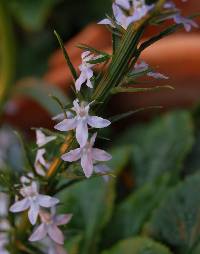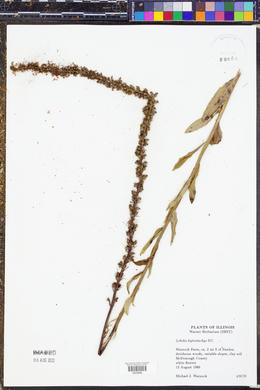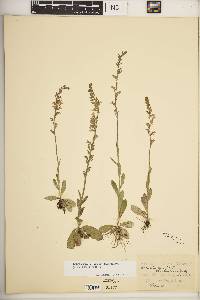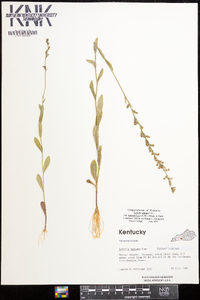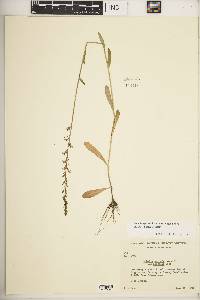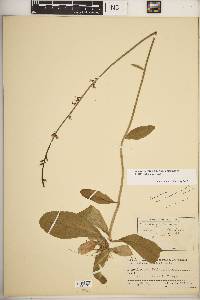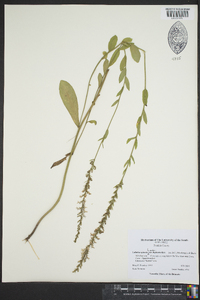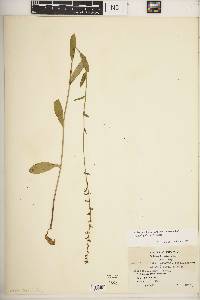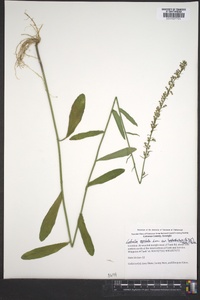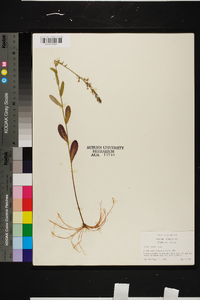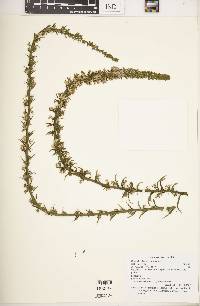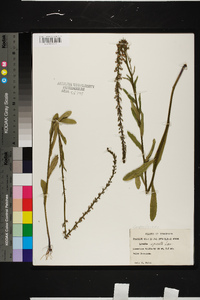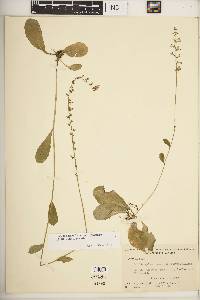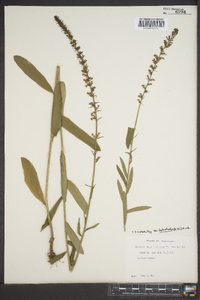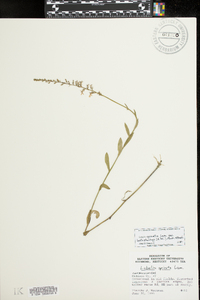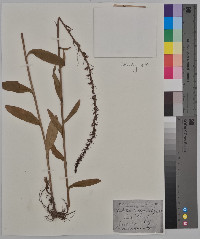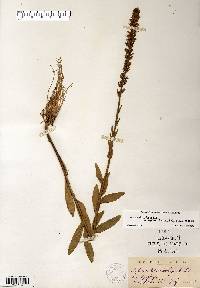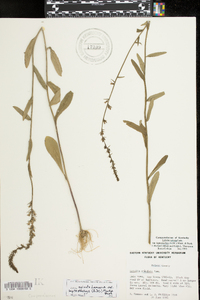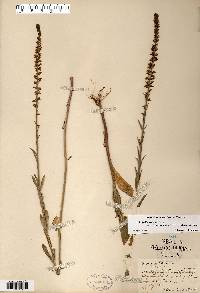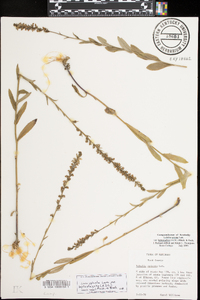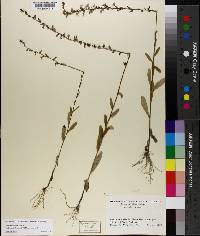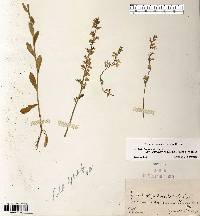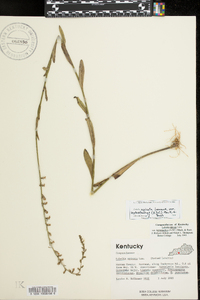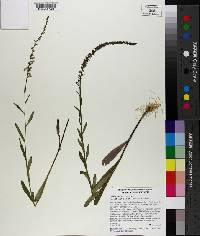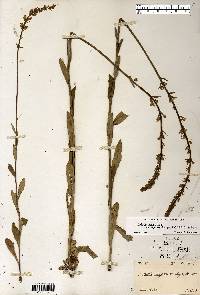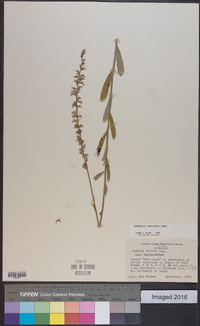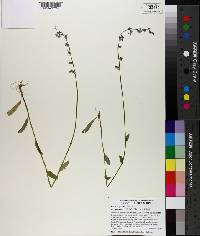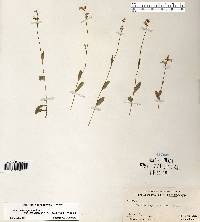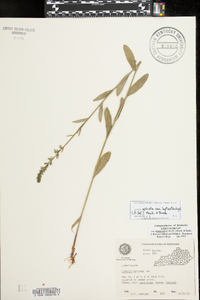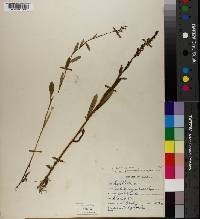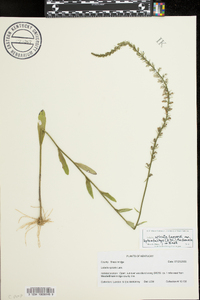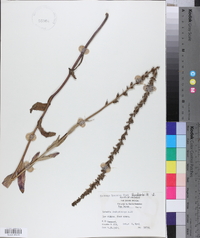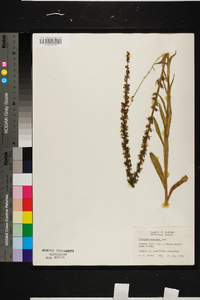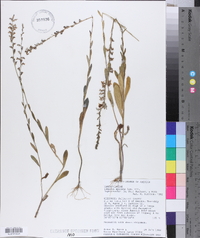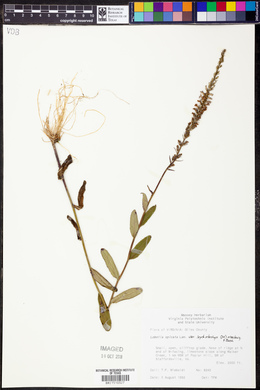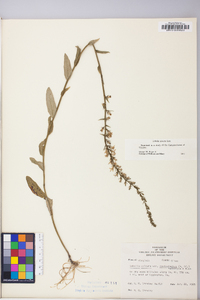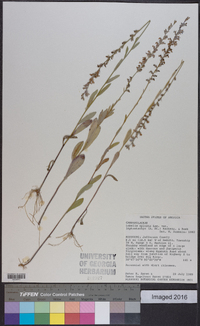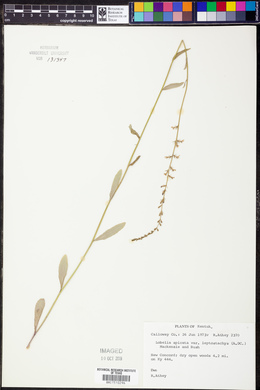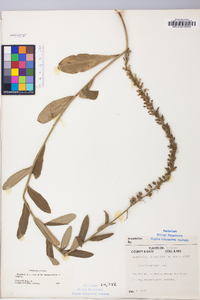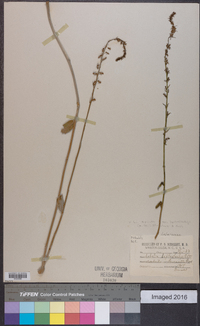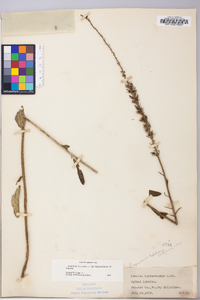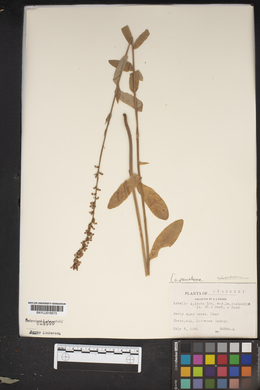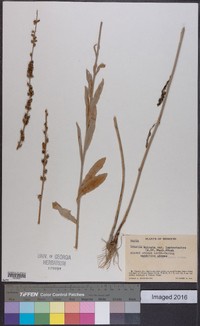Lobelia spicata var. leptostachys
|
|
|
|
Family: Campanulaceae
Pale-Spike Lobelia
[Lobelia leptostachys A. DC.] |
Perennial herb 30 cm - 1 m tall Stem: unbranched, erect, often short-hairy at base and becoming less hairy upwards, often with hairs in lines. Leaves: many, alternate, appressed, stalkless, often hairless, more or less oblong, narrowed at base with some basal leaf tissue continuing onto stem (decurrent). If basal leaves are present, they are about the same size as the stem leaves. Inflorescence: a single, terminal, unbranched, slender, very tall (20 - 50 cm), dense, spike-like cluster of flowers, each on short (2 - 5 mm) stalks in axils of hairless, lance-shaped or linear bracts. Aside from the narrow subtending bracts, each flower stalk has two, tiny bracts (bracteoles) at their base. Flowers: pale blue to white, 0.7 - 1.1 cm long, bilaterally symmetric, with two-lobed upper lip and three-lobed lower lip. The flowers are actually flipped upside down so that the morphologic upper lip (of three spreading lobes) appears on the bottom of the flower, and the two shorter and erect lobes at the top of the flower are actually the morphologic lower lip. Sepals: five, but fused at very base, then separating into five, hairless or sometimes finely hairy, long (over twice length of tube), narrowly lance-shaped lobes with obvious, long, slender, deflexed ear-like appendages (auricles) between lobe bases. The sepal auricles arise from the sepal veins, hang downwards often to the base of the sepal tube, and are typically at least 1 mm long except in our region they tend to be shorter. Petals: five, but fused at base into a tube, then separating into two lips. The "upper" lip (morphologic lower) has two, erect, narrow lobes with a beard of hairs near their base, while the "lower" lip (morphologic upper) has three, much wider, elliptic, pointed-tipped, spreading lobes. Stamens: five, but fused into a tube with pale blue-gray fused anthers, two of which are bearded at tip and shorter than other three. Pistil: with a two-chambered, inferior ovary; one long style positioned through center of stamen tube; and a two-lobed, often fringed stigma. As the style elongates up through the stamen tube, it pushes the pollen out of the anthers. Fruit: several, two-chambered, short, hemispherical, many-seeded capsules, which open at top. The united portions of the sepals and petals enclose the capsule and may become slightly inflated (or not) as the fruit matures. Similar species: Lobelia spicata var. leptostachys can be distinguished from the typical variety of L. spicata var. spicata since that variety has more spreading or just ascending leaves, and only very short auricles (if any) on the sepal tube. Lobelia spicata var. hirtella differs by being smaller overall, and obviously rough-hairy on the stem, inflorescence bracts and sepal lobes. Small plants of L. spicata var. leptostachys may be confused with L. kalmii, but that species has linear and hairless stem leaves, the bracteoles are located near the middle of the flower stalk, and the sepal lobes are usually shorter than twice the tube length. Another species this could be confused with is L. inflata, but that species usually has stem leaves that are widest near the base, the inflorescence is branched, there are no auricles on the sepal tube, and the tissue around the fruit is greatly inflated. Flowering: May to August Habitat and ecology: Less common than probably evidenced by our collections, this variety typically prefers dry soil. Occurence in the Chicago region: native Notes: Lobelia spicata var. leptostachys is seen more commonly to the south of the Chicago Region, typically north only to West Virginia in the east, and north to Kansas in the west (Gleason and Cronquist 1991). However, some of our specimens clearly approach this variety in terms of the prominence of the deflexed auricles between the sepal lobes. In comparison to specimens from more southern states (e.g. Georgia), the sepal auricles of Chicago Region specimens are smaller and often only half the size of southern specimens (Tonkovich, personal observation 2001). Still, compared to specimens of the typical variety of L. spicata, the Chicago Region specimens annotated to L . spicata var. leptostachys clearly have deflexed sepal auricles measuring up 0.7 mm long. More study is likely necessary to ascertain if any of the varieties of L. spicata are regionally separable or if they just grade into one another. Etymology: Lobelia is named after Mathias de L'Obel, a sixteenth century Belgian botanist. Spicata comes from the Latin word spico, meaning "to have spikes or grow in ears" (as in corn). Leptostachys comes from the Latin root word lept, meaning thin or slender, and the suffix -stachys, meaning flower spikes, thus referring to the narrow flower spikes. Author: The Field Museum From Flora of Indiana (1940) by Charles C. Deam Infrequent to rare in all parts of the state in dry soil in rather open woods, clearings, prairies, and fallow fields and along roadsides. .…… Indiana Coefficient of Conservatism: C = 7 Wetland Indicator Status: FAC |


